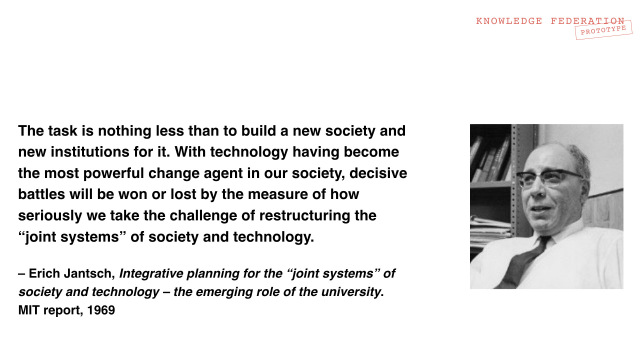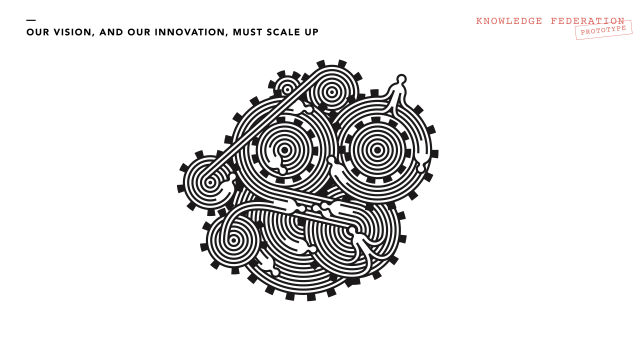Holotopia: Power structure
Contents
- 1 H O L O T O P I A: F I V E I N S I G H T S
- 2 Power structure
- 2.1 Power structure wastes resources
- 2.2 Power structure causes devolution
- 2.3 Systemic innovation is the solution
- 2.4 Ideogram
- 2.5 Keywords
- 2.6 Power structure
- 2.7 Systemic innovation
- 2.8 Prototypes
- 2.9 Knowledge Federation transdiscipline
- 2.10 Healthcare as a Power Structure
- 2.11 The Game-Changing Game and The Club of Zagreb
- 2.12 Authentic Travel
- 2.13 Collaborology
H O L O T O P I A: F I V E I N S I G H T S
Power structure
Powered by ingenuity of innovation, the Industrial Revolution revolutionized the efficiency of human work. Where could the next revolution of this kind be coming from?
We look at the systems in which we live and work. Imagine them as gigantic machines, comprising people and technology, whose function is to take people's daily work as input, and turn it into socially useful effects. Incredibly, the ingenuity of our innovation has been focused on small gadgets we can hold in our hand—and we overlooked this far more important frontier.
Power structure wastes resources
The Ferguson–McCandless–Fuller thread is intended to serve as a parable, pointing to the wastefulness of our core institutions or systems in general (in this example they are represented by finance, and governance tainted by "special interests"). See it outlined on Page 4 of this article, and also here.
This conclusion suggests itself.
We have the resources needed to take care of world's problems. Our root problem is in the structure of our systems—which determine how those resources are distributed and used.
Power structure causes devolution
The question may be asked, Why, indeed, are we so prodigiously successful in creating miniature gadgets—and flagrantly those gigantic ones? Why don't we adapt them too to the purposes that need to served? <p>The reason is that to do that, we would need to collaborate in ways and on scales where we have only learned to compete.
We ignore the possibility to tune the systems in which we live and work to their societal purposes, because they serve for us an entirely different purpose: They organize us against each other, and give a relatively stable structure to our various power strifes.
But what sort of world, what sort of systems, does this lead to?
The Chomsky–Harari–Graeber thread is intended to serve as another parable. It points to a sobering conclusion: The social-systemic "survival of the fittest" favors aggressive systems, which are damaging to both our culture and ourselves. See it outlined here. Conclude with the reflection on Joel Bakan's "The Corporation", which follows. It will show that although the results of this systemic devolution may look different in our time than they did centuries ago, their pathological character has remained unchanged.
Systemic innovation is the solution
Erich Jantsch's insight
Having delivered the opening keynote at the inaugural meeting of The Club of Rome, Erich Jantsch clearly saw what needed to be done, if the "problematique" was to be resolved (see it outlined here and here).
Our society needs a new capability—to update the systems in which we live and work. Jantsch called it "systemic innovation", and we adopted from him this keyword.
We let Jantsch be the symbol of a missing link between two bodies of work and lines of interest: cybernetics or the systems sciences, and the need to make our civilization "sustainable". In this present holotopia prototype, those interests are symbolized respectively by Norbert Wiener and Aurelio Peccei.
Ideogram
The System ideogram suggests that our institutions, or more generally the systems in which we live and work, need to be perceived as gigantic mechanisms, comprising people and technology; and also handled accordingly.
The socio-technical systems determine what the results of our work will be. They form an environment by which our life quality is determined, and in which our human quality either grows or decays.
Keywords
Power structure
Every genuine revolution—and our proposed revolution in knowledge and awareness is not an exception—is also a revolution of the way in which power relationships, or "justice", are perceived and handled. We coined this keyword to point out where the next such revolution may be coming from.
The power structure keyword models the intuitive notions of "power holder" and "political enemy"—in an entirely new way. (All five insights are required, however, to understand its meaning fully and correctly.)
George Bernard-Shaw's dictum is familiar:
“All professions are conspiracies against the laity.”
"The conspiracies refer to the methods used by professions to acquire prestige, power and wealth", explains Wikipedia.
The power structure keyword allows us to extend his insight, by observing that the professions can be, and surprisingly often also are, conspiracies against the professionals themselves as well! They make the professionals busy and stressed competing with one another—and still leave the society's purpose ill-served. Our society remains non-[[wholeness|whole], and all of us with it.
The power structure may be understood intuitively as societal cancer—a 'malignant' growth of otherwise normal and necessary societal 'tissues', which saps the organism's vitality and disrupts its health or wholeness.
On occasions, we used the power structure definition to argue that the proposed approach to knowledge is a necessary element of our 'societal immune system'; because without it we could not even see the enemy. See the blog post Holoscope for the Buckminster Fuller Challenge, where the history of the power structure definition with links is summarized at the end.
Systemic innovation
To restore agency to information, and power to knowledge, we must develop ways to extend them into systemic change. That is what systemic innovation is about.
Systemic innovation can be interpreted in two ways: As "making things whole", and as innovation on the scale of basic socio-technical systems. Both are needed to counteract the power structure devolution, and also closely related.
Prototypes
Knowledge Federation transdiscipline
The Knowledge Federation transdiscipline is a prototype of what Erich Jantsch was calling for—an academic institution that is capable of federating information into systems. The method we use is straight forward: We create a systemic prototype, and organize a transdiscipline around it to update it continuously, by weaving together relevant disciplinary insights. The Knowledge Federation initiates or bootstraps this approach by creating itself as a prototype of the transdiscipline (a brief illustration of our systemic innovation-related network building and collaboration is presented here).
This self-organization was initiated at Knowledge Federation's second biennial workshop in Dubrovnik in 2010, and announced publicly at our first international workshop, within the Triple Helix IX International Conference at Stanford University, in 2011. See the blog report with link to article here. See also our concise summary titled " Enabling Social-Systemic Transformations", contributed to the "Transformation in a Changing Climate" conference.
Healthcare as a Power Structure
Maintenance—as a rule of thumb and orientation—is so much more effective and so less costly than repair; why isn't our healthcare conceived accordingly?
Could even healthcare develop 'cancer'?
The "Healthcare as a Power Structure" prototypes both an application of the power structure theory, and an attempted systemic innovation in an existing field of research (we proposed our methodology, the polyscopy, to the European Association for the History of Health and Medicine as a way to extend their traditionally historiographic orientation, by developing "laws of change" results). See the abstract. We used our Werner Kollath vignette (itself a testimony of a historical attempt at systemic innovation in healthcare) as part of the justification of our prototype.
Our study was done in collaboration with European Public Health Association, through Prof. Gunnar Tellnes who was our coauthor, and the association's president.
As prototypes tend to, this prototype provides a template for applying the power structure theory to other systems.
That the academia too has not been spared from power structure deformations has been reconfirmed by the histories of Erich Jantsch, Doug Engelbart and other pioneers of knowledge federation and systemic innovation. And by the history of our present initiative (an early account begins here).
The Game-Changing Game and The Club of Zagreb
Here is what we, as a human generation, need to make our priority: To empower the coming generation to update the systems in which we live and work. And in that way become capable of crafting their future.
The Game-Changing Game was a system in which elders in power positions, called "Z-players", empower the younger (in life and career phase) "A-players" to "play their life and career games" by changing systems, instead of conforming to the existing ones. Hence The Game-Changing Game is a generic system for changing systems. See our brief outline, with links, here.
The Game-Changing Game was one of the experiments that led to holotopia.
The Club of Zagreb was our update of The Club of Rome, based on the insights outlined above, and The Game-Changing Game. See it described here.
Authentic Travel
All our prototypes can be seen as examples of systemic innovation in specific domains of application. We make systems whole by (1) 'connecting the dots' to identify the changes that need to be made (2) weaving them into design patterns, to compose a real-life prototype. Under the theme authentic travel, we developed a collection of such prototypes.
Since the beginning of civilization, people traveled to become acquainted with other cultures, and by so doing also with their own. But mass tourism, being more cost-effective, constituted a power structure devolution. Can this trend be reversed?
Our prototypes feature re-designs of the conventional corporate model, and the tourism or travel itself, to empower small economies and cultures, stimulate cultural exchange and post-war revitalization, and promote cultural and human authenticity. A summary with links is provided here.
We also devised a method called "memetic engineering"—for empowering endangered or remedial cultural memes, by combining them with business ones, (see it described in this article). </div> </div>


